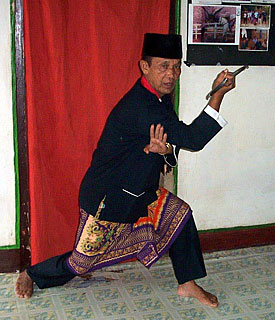Why P.C.P.S American Pencak Silat is not the same as other martial arts or other Silat styles you may be familiar with, and why you need this art for your survival and health maintenance, both internally and externally. The first thing a person needs to do when deciding on PCPS, compared to other arts, is just take a look at how we move, while delivering blows and compare that to the other arts. Intuitively, when I first saw the fighting movements I was drawn to it, I just knew, the movement was at once pleasing and at the same time, frighteningly deadly. Not in a way that was purely physical, but deeper, psychologically it had an allure and at the same time a feeling of great potentially impending danger, like when you watch a big cat stalk prey and coil its body to spring. Through the years and many trips to Indonesia, looking for a real internal art I came to realize what they show you, like the Chinese also do, is mostly a fake show, either played along with by willing students to appease the master by acting along, or in some hypnotic trance the school puts them in prior to the show and or also mixed with Islamic indoctrination on a subtle level (say these magic mantras, which are in fact all just prayers to Allah , not magic words at all ). Even if you ask the meaning of what you’re asked to say, many of them will tell you it’s better for the magic if you don’t know!
In fact, there really was a true internal art, but it was based on the moves only a few masters I saw had intuitively picked up on, and did so accidently. Studying the best examples of this, along with the physics, biomechanical attributes of the body and finally the synchronization of those things with all the natural movements of the joints and spine in the body a pattern was exposed. This came to full light with the addition of the blueprint of the building blocks of the universe laid out in the formula called “The golden mean,” and this was applied for the finishing touches. This took decades to decode and only in the last few years has come to full fruition.
All this put together in one art is what I bring to the table. This is what makes this art mine. This strips bare the mystique and turned the only occasional glimpses of this movement, scattered throughout the world, discovered by accident by a few with no idea why, now, into a set out, written explanation that in my art is not happenstance but occurs with every single move. This is a major breakthrough found nowhere else that I have yet to see.
When this is accomplished from the inside of the body out, there are signals these moves send to the subconscious mind of the opponent about what he believes he perceives will happen next. This then creates multiple automatic reactions in their body they can’t escape from doing, because it’s an instinctual auto-survival response! Simultaneously these methods transform the practitioner’s body into a unit of coiling powerful waving energy. This revelation was what eventually took my real interest. It’s a physical –internal – psychological result that I came to teach as the first part of the physical –internal art that is completely missing from all other Indo –Chinese arts I ever saw, not to mention mma, krav maga. etc etc., etc., etc. Which have no semblance of it at all. As a matter of fact, the very core of most of them is diametrically different, which is to keep the spine rigged, as an example, as an axis, which on the contrary to helping, as they believe it does, completely destroys the energy flow and potential power in the body and in turn creates internal and physical blockages which damage the practitioner. The only one being defeated is the martial artist who repeats the errors. This stiffness and created blockage over a long period of time can create things like arthritis, spinal energy blocks which can lead to disease, and cancer etc., anywhere in the body and less delivered power on all blows. Not to mention the never discussed rebounding energy back into the body that exists from every blow which lands and then recoils back into the practitioner, further damages the stiff areas this collides into like the locked spine. These are but a few of the damaging side effects of restricted nerve energy and blood supply to the body created by the postural defects that are taught as needed, in other martial arts. Stop the damage to your body, now!
I keep watching people bring in “Masters“ for seminars and each one winds up striking the same, physically, they may have a different applications perhaps for some defense or attack scenario but the method of the delivery of their strikes is constant, all the same, all the time and contrary to both health and speed, power and efficiency. You are being handed the same song over and over, just dressed up differently. You can bring in 100 people like this and you still won’t have the proper body mechanics. Only those are vital and unchanging. After you grasp this concept then the different techniques can have far more efficiency for you and no, it’s not some dance you do before you strike as the un educated may think. In fact it’s a vital error now seen in most all Silat from Indonesia. The entire bodies movement at all times and especially when hitting must conform to the rules of life and creation or suffer the dire consequences. Yes we hit and fight from the moves, not after them.
If you don’t do that, you’re at the kindergarten level. If you move first and stop to hit, you are completely in the dark and are practicing a façade of what it should be and you’re doing those moves for nothing but a phony show.
Big muscles, cross fit and lifting weights won’t help you, and can actually act in reverse and stiffen you if you are not very careful and do not understand these concepts. Time and again I have trained people and watched them transform into a wonderfully lithe moving martial artist, then saw them years later, as they fell back into other ways and saw a complete degeneration of their moves and energy, life to death before my eyes. Beauty to an ugly stiff caricature of their previous self they now sell as their art, sad.
When you get tired of different people showing you different tricks in the same old package, of delivery when you get tired of not progressing, of your body not being able to do what they show and getting stiff and sore and you really want a unique body and mind and spirit bldg. art, enroll in PCPS American Pencak Silat. You don’t need to pay for a year in advance, attend expensive seminars to progress, or pay each year to see 5 different people from far away confusing the hell out of you, simply to make seminar promoters rich, come join us. PCPS American Pencak Silat adjusts to your age and body type as it’s naturalistic.
Below is a letter I received from a current student. This is the type of student we create. If you’re worth it and one of the chosen few who can appreciate this high level art, come join us. Read this, does your art offer this for you?
Pukulan Cimande Pusaka Sanders is as complete a martial arts experience as a student could want. It is deeply rooted in Pendekar’s research into the historical Pencak Silat of Mas Jud as well as the unique refinement and innovations yielded by a lifetime of practice. At its heart, PCPS is the embodied practice of deeply rooted truths which span the history and spectrum of human experience. A student who is open to PCPS’s teachings will find that it integrates physical, emotional, mental, and spiritual lines of development. The physical components and principles of the art provide the practitioner with the potential to successfully deal with a wide variety of threats. These same physical movements, when performed correctly, utilize breath work and mindfulness practices which engender similar health benefits to meditation, yoga, tai chi and qi gong.
Because PCPS is based on deep truths intimately tied to physics, biology, and psychology, its practices have a broad base of application, one seldom found in most martial arts. Martial arts are attempts to “map” the potentiality and prepare to cope with the actuality of combat. Often, the way in which many arts such as Karate and Kenpo (I say this as a former student of those arts for over 20 years) are presented provide a “street map” of an Okinawan town 100 years ago. PCPS is more akin to a current, updated topological map.
PCPS is not just a martial art. It is an art that utilizes the energies of the body, mind and soul (psyche) under the direction of (in surrender to, relationship or union with) The Spirit. The physical movements and breathing as taught by Pendekar Sanders, incorporates twisting, spiraling, coiling and whipping dynamics which stretch and work the joints, tendons and muscles. In this way it can serve a purpose similar to the movements of hatha yoga. This can also provide benefits similar to the practice of chiropractic and old style osteopathic medicine, which focus on improving the health of the spine, the individual vertebra, and nerve channels. The practice also opens the channels/meridians, the nadis, especially the ida, pingala, and sushumna which also lay along the spine, similar to the various traditions of kundalini yoga. It can also enhance awareness of the various nerve plexuses which correspond to the chakra system. The visualizations and rituals taught by Pendekar on his most recent DVDs encourage the qualities of mindfulness and enhance and strengthen all of the above effects and their benefits.
Pukulan Cimande Pusaka Sanders is an integral method, with the potential for healing and developmental impact across the entire spectrum of human experience. Within PCPS we find practices similar to other methods (martial and yogic) however, in PCPS they usually employ a greater degree of dynamism. As mentioned earlier, PCPS can manifest similarities to various psychophysical schools of yoga ("union" or "yoking") such as the hatha, kundalini and Kriya methods. These practices all tend to evoke the experience of an "upward" flow of spiritual/conscious energy called Kundalini (the serpent/spinal energy) in the Hindu tradition. This occurs through disciplined practice, avoidance of indulgence, ethical living, breath-work (pranayama), inversion of attention, concentration, meditation and contemplation. Of course, all of this could be part and parcel of PCPS practice; however, PCPS, American Pencak Silat practice actively includes a superior Ancient Christian Angelic internal portion such as in Orthodox Christian esoteric practice.
“The Internal Keris DVD is amazing. It outlines the ritual, generative practice of venerating the Keris in PCPS. Pendekar begins with the historical background with regards to the Circle of Creation and its relationship to elements, Archangels and the Keris. He explains the distinction of the Keris as Icon for veneration (as opposed to an Idol for worship) and its relationship to religion in general and Orthodox Christianity orientation in particular. He covers various aspects of spiritual meaning for both the Keris itself, and the ritual demonstrated later. This was a particularly interesting part for me, where we hear Pendekar explain the syncretic nature of religion in Indonesia and also his personal evolution which culminates in leaving other belief systems and engaging Orthodox Christian practice. The DVD ends with a step by step demonstration of the Veneration of The Keris and an explanation of its symbolism and deeper spiritual meaning. Pendekar ends by explaining that although the practice is demonstrated in a Christian way and that this is the "PCPS way", it could, as a practice, be oriented to other religions. Awesome DVD with a wealth of information for those looking to attune to the deeper aspects of the art. Gives us a glimpse into the depth of our PCPS cultural heritage, our history and lineage, and provides a ritual practice which can provide another way to connect our martial methods to out spiritual path.
Thanks Again "Pendekar”
Ryan Valentine
Our style has its roots in the region of the world known as Indonesia and falls under the general category of martial arts known as: Pencak Silat. To understand who we are you should first look at the various streams that make up our art.
A Brief Look at the Evolution of the Pukulan Cimande Pusaka Curriculum
1984
I had a school in Washington, Pennsylvania for which I designed a curriculum based on the material that I had at that time. Most of this material was what I had learned from the 15 years with John Malter in the Willie Wetzel tradition.
1987
Pendekar Jafri gave me the name of my art, Pukulan Cimande Pusaka and I created a curriculum based on what I had learned before and the materials learned from the Pendekars in West Java. I also added more of the interal side of the art through my training with Pendekar Sartono.
1990
I refined the curriculum that went with my books and my distance learning program which Craig Porter helped me with, sending out letters and it was used with the weekly classes I had at my home for the many students like Craig Porter and Bill Birge and others who trained there.
1994-1995
I gave the curriculum to the teacher of the Michigan King Dragon School to use as a model. At this time this commercial school made requests to alter my curriculum to suite their own needs to generate more income. At that time to spread the art I agreed if they kept to my material.
1995-2007
Many schools I went to do seminars at including those abroad demanded they each have their own spin on the curriculum. Some even added names of ranks I never used to create more levels to keep students wanting more for increased income again, some shared it with other schools, some accepted others ideas and some rejected them. It was the Wild West.
When I went to each school I presented my material and each of them fit it in as they demanded for their students and created their own ranking system. This is why I had to ask each teacher to print me off the curriculum I was working with when I went to share my material. There was no way to memorize everyone's spin on ranks and titles. This was responsible for mass confusion and unequal training. No one had the corner on any curriculum and everyone was doing my material in different steps.
2007-2012
As I discovered more of the actual Mas Jud material I added or subtracted items as needed. The 18 Standing Jurus were removed since after extensive research they were not part of the Mas Jud system and the Sera-Depok Jurus were added to stay true to the original quest. Some schools kept up, others fell behind and even refused to do the correct material from me. Some lacked the mental understanding and physical dexterity to even perform the new material.
The true head of the art was a living art and required adaptations as new facts were discovered.
That is why now I have gone back to only my curriculum, the one and only way. Everyone is equal and I grade them al and no ranks are just handed out. Those who will not or cannot conform must choose another path.
The individuals and small groups we have now everywhere have achieved a much more uniform and together group without all of the egos that created the former problems.
So come join us in unity.
Influences Chart
This chart is not complete in that it does not give the complete lineage under each person. The purpose of this chart is to show you the various pieces that had and do have an important influence on our art. This chart is from our book on the Historical Mas Jud.
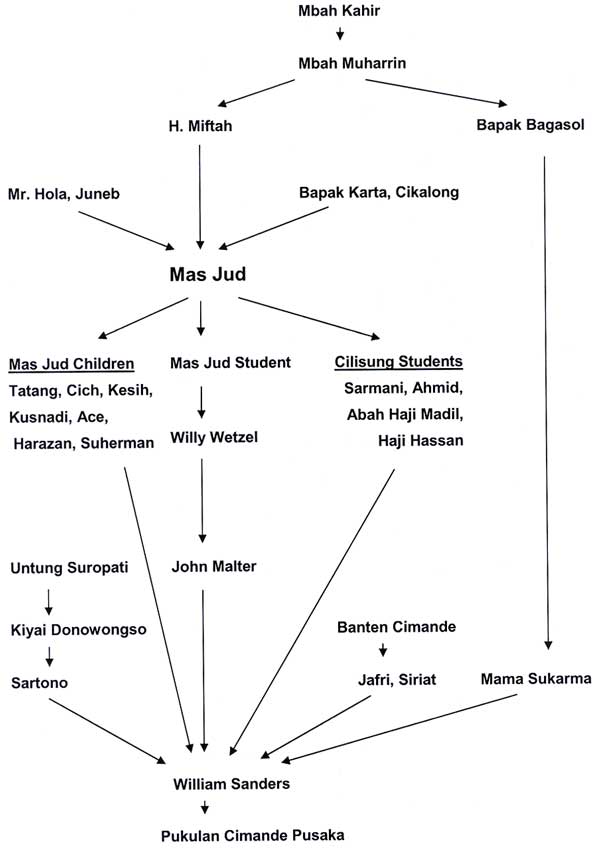
Our Name - Pukulan Cimande Pusaka
The name was suggested and sanctioned by Pendekar Suryadi Jafri the then official representative to the USA from the Indonesian Pencak Silat association at the time.
This name was suggested to me from him while I was in Java with him and the name was approved by all others in attendance as well.
The Name gives honor to:
Pukulan
… to Master Wetzel and his lineage
Cimande
… to Pendekar Suryadi Jafri, Pendekar Mama and the Mas Jud lineage
Pusaka
… simply means a cherished family heirloom to be passed on and as we pass this art, my art down to the generations, it is indeed our “Pusaka”.
It was with great respect for Pendekar Jafri that I accepted the name of the art and that names gives his spirit honor. The name has always been embraced by every teacher I have had in Indonesia and while I was traveling there was there a single objection to it in any way. I will never disrespect the spirit of the late Pendekar Jafri by altering his wishes for the name our art as he was a good friend and one of my teachers.
Some Claim
"their Indonesian Brothers and Sisters don't like the word Pusaka in the name".
The above explanation outlines that in fact the name came from the highest rank of an Indonesian Master from Indonesia who was acting at the time in official capacity for Indonesia.
In addition the few recent individuals who expressed dislike for this name also said there should be no “Guru Besar” title used in any form using the name Cimande. While that is not my viewpoint I find it interesting that these individuals who "valued" the opinion of these people about the name, decided they could care less what they said about their rank and have held on to that title anyway. I suppose that is called discretionary concern for “the Indonesian Brothers and Sisters”.
Guru John Malter direct student of Master Willie Wetzel
Diploma From Guru John Malter
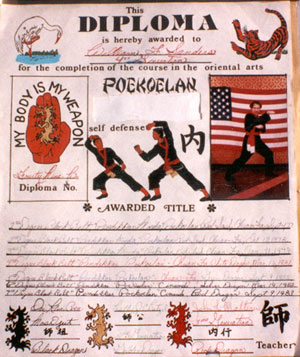
Photo of Guru Malter
He is holding the Cabang in "his" left hand and its design was passed on from Master Wetzel.
Master Wetzel got this design from the students of Mas Jud.
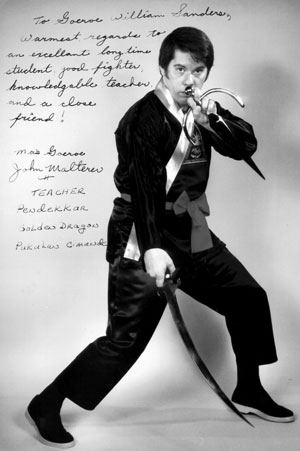
Basic Information
How long did you train with John Malterer and what was the highest
rank that you received?
I trained with John Malter from late 1972 until 1983 when I was awarded
the title of 7th Degree Red Dragon.
Pendekar Sanders, what made you pick an unusual art like Pencak Silat?
I was looking for a fluid, powerful fighting art, and I liked the movement
of some of the Kung Fu that I saw, but I could not find anything that
I really liked. I went to see an Indonesian Martial Arts demonstration
by Guru John Malter and his students. I liked what I saw, and so I
began my training in 1972 in Wheeling, West Virginia. Guru John Malter
was a long time student of Master Willy Wetzel.
What can you tell us about Master Willy J.C. Wetzel?
I was told that Master Willy John Christopher Wetzel was born on January
23, 1921 in Loemadjang (Dutch spelling), Java, Indonesia. Jane ( Master Wetzel's daughter) claims that both of his parents were Indonesian.
Master Wetzel trained in West Java and in WWII he
was in the Royal Dutch Indonesian Army. In 1949 he moved to Holland
and in 1956 he immigrated to Vanport, Pennsylvania.
Master Wetzel had
4 children - 3 sons, Roy, Wim and Jim and one daughter, Jane. Around
1960 he opened a school to the general public in Beaver Falls, Pennsylvania
and several of his students were John Malter, Barbara Niggel and Bill
Dobich.
He died on March 17, 1975 in Beaver Falls.
Did you ever meet Master Wetzel?
No, I never met Master Wetzel, but I saw videos of him and I did considerable
research on him through his students and friends.
Of all of the
teachers that I have seen in America, I never saw any of them who could
move and fight like he could.
His art was much more fluid and complete.
Is Pukulan Cimande Pusaka the synthesis of a Chinese style and Pencak
Silat Cimande?
John Malter taught us, as he
had been told, that the art was a synthesis of Chinese Kuntao from
Oei Kim Boen and Indonesian Pencak Silat Cimande from Mas Djut
Bang Solimon.
Please note Oei Kim Boen is not a Chinese name and
Mas Djut Bang Solimon is probably not a complete name. They supposedly
called their art Pukulan Cimandie, (Dutch spelling Poekoelan Tjimindie).
Later when I spoke to many people, including Guru Wetzel's sons,
I was told the story was a fairy tale. Roy Wetzel's exact words
to me were, "You did not believe that fairy tale did you?"
I also visited Mr. Vanderlee, a man who had spent years with Guru Wetzel
both in Indonesia and in a Japanese prison camp. Guru Wetzel had offered
to teach Mr. Vanderlee his art and I was told this man had achieved
a very high proficiency before he became sick. He laughed at me when
I asked about the Chinese portion. He said, "No way! Willy only
learned and taught pure Pencak Silat." I can only guess the rest.
I believe this story served as a marketing strategy to attract students
to take a look at what he had. Chinese Kung Fu was very popular during
this time and virtually no one had any idea what Pencak Silat was.
This
is based on interviews that I conducted with people in America who had
visited with Guru Wetzel. To further illustrate the point Oei Kim Boen
did not live in the same time period as Mas Djut by many dates that
I have seen. Furthermore the Indonesians do not get along well with
the Chinese.
Pendekar Jafri and I did extensive investigations in West
Java. We concluded there was no record of these two men collaborating
on an art. Let there be no mistake Guru Wetzel's art was 100 percent
deadly Silat. His art was a superior combat system, and if you saw it
you wanted it. There was no other Pencak Silat teacher that I witnessed
that had the fascinatingly deadly manner of movement that Master Wetzel
brought to America.
Can you explain the various spellings of Cimande?
Barbara Niggel teaches in Cape
Cod, in Orleans, Massachusetts and her art is named Poekoelan Tjimindie
Tulen.
John Malter teaches in Ohio and his art is called Poekoelan
Chuan-Fa Tjimindie.
About Pendekar Jafri, Pendekar Sirait and Pendekar Banten
Most people don’t realize that when I met Pendekar Jafri I was already graded as an advanced Black belt in John Malter’s system of Pukulan Ciminde (Cimande ) and at that time believe I was a 6th degree black belt . As a matter of fact it was I together with John Malter who flew to New York to work out and meet with Pendekar Jafri the first time.
After working out with Eddie for a day he wanted to spar with me and after a minute or so I connected with a punch. He clearly was not happy about that and we went on and on and he would not stop until he hit me in the eye with a solid sublet. Afterwards he said to me that he was very happy to see someone who knew the old animal styles and could actually fight with them.
We were friends from that day on and we always had those little sparring games where let’s keep going until one gets the other. It spilled into chasing each other in the airport and up and down the stairs of buildings in Java. We almost got arrested once as they thought we were really going at it.
Eddie had a great sense of humor. The day after our first match he took me to the Consulate General of Indonesia in New York to get presented with a certificate as a teacher of Cimande. I had a nice black eye for the pictures!
When Eddie took me to Indonesia it was NOT to learn Pencak Silat but to the old men he knew and to have me show them what knew.
You see he had been at great odds with the IPSI over them trying to remove the last vestiges’ of the original animal mannerisms from a purely religious point of view from the old Silat he knew and loved. It cost him to leave the IPSA and his position as USA representative over it.
When Eddie took me to Pendekar Banten it was NOT to meet the youngsters but to seek out the old masters who at that time were a big part of that organization. He had me show them the animals that I knew and I got lots of pointers on them.
He grudgingly tweaked the Jurus I had at the time but made all the fuss on the animals. (I was not so sure why at the time) Funny I went there to see Jurus not realizing what I really had. Even then the younger generation, even Pendekar Siraits own son was migrating away from the old ways. He told me that was a village system not the new way.
Eddie cautioned me that I should only seek out the very old members of Pendekar Banten and then only seek the animal knowledge that still remained. At the time I did not really understand the significance of what he said.
The role of Pendkear Sirait was two fold:
- He took me to see the old men and from took me from village to village
- He showed me the many ways to strike the tender areas using the old Cimande ways and he was evaluating me all along with the rest of them.
Pendekar Siriat was involved at the time with the ever growing political side of Pendekar Banten which sad to say in the last years has greatly foreshadowed the old way of Silat. I never went to Pendkear Banten per say to learn from any individual but was taken there by Jafri as a verification of what I already had and of course to pick up what I could to add to the arsenal.
Siriat was a very patient and kind teacher but brutaly strong and fast when he wanted to be. He was some sort of the “enforcer” for the group from what he showed me and told me.
The funny thing is although THEY verified what I was doing was to their liking enough to rank me as Pendekar after all of the demonstrations and tests I was asked to perform.
It was not until many years later and the meeting with Pendekar Mama that I started to put all the pieces together.
Finally I could see the dilemma of Jafri - the religion had taken the juice out of the Silat, the deadly animal moves were reduced to human stick man like moves with vestiges left of where they came from . Jafri and Sirait had in me a person free from the bondage of Islam to take the animals and go on with them. He carefully introduced me to only the old players who still practiced the animal styles. Siriat went along with it and took me from village to village to see the old fighting ways staying purposely clear of the more mundane Jurus or the talk of Islam.
I was not asked to convert as they wanted me away from that portion so I was wide open to the old Silat without offending the religion.
Now, finally I understand their plan. Even the promotion to Pendekar and my charter to spread Cimande was based on me doing what I knew and honoring the old ways. Pendekar Sartono was given to me to insure I would stay on the path as he taught me the Circle of Creation and where the animals went, the old ways of animism.
I was their time capsule of the old animal ways they sent of far away to insure it would not die and they gave me the highest award to insure I would pass this on.
Now it is really sad to see people running to Pendkar Banten and grabbing all the young guys who are from a different time. Then I see things like, this is not a Cimande of Animals or dance but a farmer’s art.
Well if they only understood they have been taught the stripped down religiously altered version that Jafri fought so hard against maybe they would come to another conclusion.
They even said but we did not see the snake there…
WHY DO YOU THINK THAT IS SO?
… but to each his own.
Only when I arrived at, you must admit in more than a coincidence, the very Cimande that Mas Jud learned, from the same root was I able to link the animals to the Jurus and see which Juru was taken from what animal.
Once I made the connection I was able to reinsert the animal mannerism that originally gave birth to that Juru and now that Juru was devastating.
BUT ONLY with the knowledge of the animals was I able to supercharge the Juru.
The plan of my old friend and teacher Pendekar Jafri, Pendekar Sartono and Pendkear Sirait and all they brought me to has finally produced fruit.
Of course again I thank Guru John Malter for passing on to me the first animal techniques I had that he learned from Master Wetzel of the Mas Jud lineage (Ujud).
Pendekar Banten Photo Set
The Pendekar Banten Organization
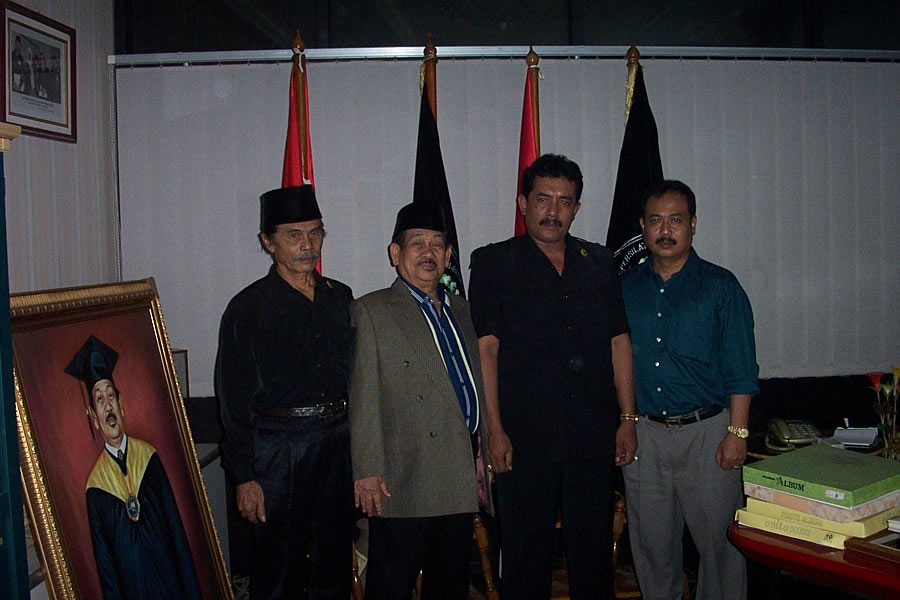
Pendekar Banten Book given to Pendekar Sanders as a gift

Pendekar Sanders and Pendekar Jafri training in West Java on the rim of a volcano
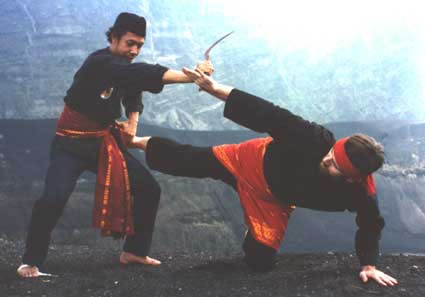

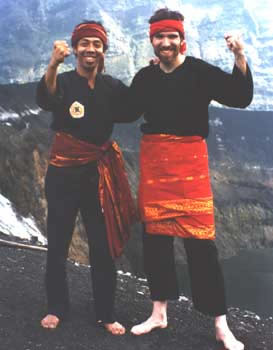
Pendekar Sirait (deceased), Born Sumatra

Pendekar Banten Logo

The
outside of the patch is a pentagon which the means the PPPSBBI is based
on the five principles. Pancasila is the five mutually reinforcing principles
that define both thte nation and the people of Indonesia.
The star, in the center near the top, represents the Divine presence
overshadowing humanity and the activities of the organization and its
members. The flag, in the center, is red and white and represents courage
through purity. The crossed arms, in the middle, represent the vow of
the Pendekar to protect the meek, the innocent and the truth.
At the corners of the flag there are sticks with chains on the ends.
These are sharpened bamboo which had a historical significance of the
Pendekars in Banten fighting against the Dutch. The chains on the ends
symbolize the imprisonment that they were fighting to break. The pedang,
pointing upward in the center with the handle just below the flag, represents
Banten as it is famous for its use there in combat and in ilmu.
On the right side of the flag we see cotton bolls. Cotton is used to
plug the orifices of the dead and cotton cloth is also used for the shroud.
On the left side of the flag we see rice leaves. Padi or rice is what
people eat for sustenance and thus, the two symbolize life and death.
Padi and cotton are also the symbols of what a student was to offer the
teacher, that is food for training and cotton for clothes. If the student
was to get killed in his training it was the cotton that would be used
to wrap the body for burial.
These symbols are also found in the Garuda
Pancasila as they represent “Sandang,” and “Pangan,” “cotton
and “rice.” Sandang and Pangan are two of the three primary
needs in Kejawen philosophy. Sandang represents clothing, protection,
etc. Pangan represents the source of human’s primary need for life.
Pukulan Cimande Diploma given to Pendekar Sanders 1987
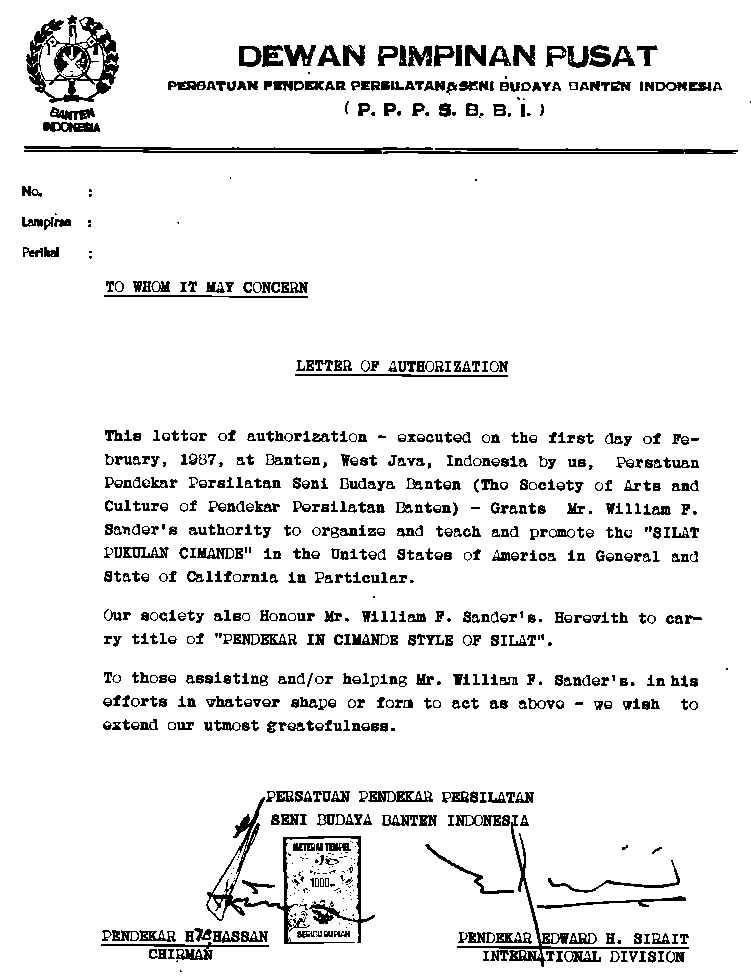
About Untung Suropati and Pendekar Sartono
In 1603 when Indonesia was a Dutch colony a Govenor General, General Edeleer Moor, adopted a young Balinese who was a descendent of a high caste Balinese noble family. His name was Untung.
When he was old enough Untung joined the Dutch army. During this time Untung had been seeing the General’s daughter, Suzane Moor and without her father’s permission she married Untung. Being in Java the marriage was performed by a Moslem Canonist. When the General found out he sent Untung to jail to be executed. His wife, who was pregnant with his son, was exiled back to Holland. In prison Untung was tortured badly. With great effort he escaped with a group of his friends.
After a few revolts against the Dutch, outnumbered he left for Cirebon. Cirebon is a port town on the northern coast of Java and was wedged between the warring kingdoms of Banten to the west and Mataram in the interior. At that time the mayor of Cirebon had a son whose name was Suropati, a rude and violent young man. Disliking Untung he attacked him in a fight to the death. With his Pencak Silat Untung killed Suropati. Because the mayor liked Untung and did not approve of his son’s behavior he gave the name Suropati to Untung as a badge of honor.
From here Untung Suropati traveled south to Tasikmalaya in Rajapolah which is 57 km east of Garut and 116 km southeast of Bandung. Eventually Untung married the daughter of the sultan. In a special ceremony he also married her “genie”. Because of this when they had two children, they could live in both worlds – physical and astral. Their names were Embah Adisana and Embah Samber Nyawa. Through his wife and children Untung Suropati learned the secrets of the other world, i.e. contacting deceased masters, etc. He used his knowledge to develop his Pencak Silat fighting powers for combat and enchantment magick and so became the first of our lineage of the Byang-Byang Naga Penglima (Shadow Snake Warriors).
After constantly refining his internal art he then traveled southeast to kingdom of Mataram (present day Yogyakarta). Because of his great skill and power he became minister to the King. The King called him Tumenggung Wironegoro and the Pasuruan Region was his authority. The name of his group of men, (troop in the army), was “Wirodimejo”. In battle in 1649 Embah Untung Suropati using his magickal and physical abilities against guns, fire and a vastly greater number of enemies was able to save his men.
Alive, but very weakened he went to a village called Randatelu and then returned to the castle where he died in 1649. There are a few different dates recorded in the places one finds reference to Embah Untung Suropati but I use the ones supplied to me from my spiritual teacher, Pendekar Sartono a direct lineage holder from Embah Untung Suropati.
Pendekar Sartono’s teacher was named Pendekar Kiyai Donowongso, “descendant of the fourth”, and on August 30, 1985 I was added to this lineage.
Ink Drawing of Untung Suropati which resides in his old house
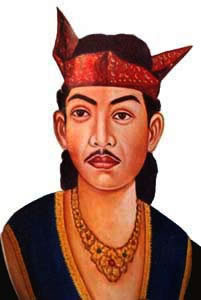
Pendekar Sartono as a young man
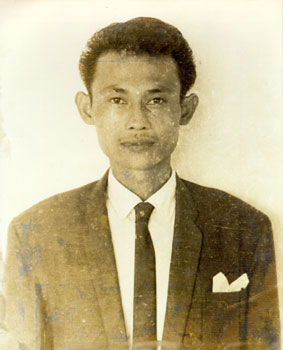
Pendekar Sartono with his family and Pendekar Sanders in the back, 1985

Pendekar Sanders Pendekar Sartono 1985
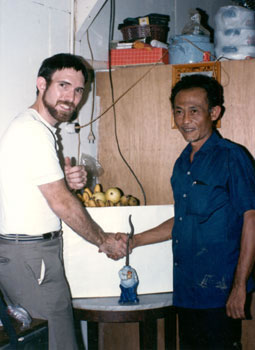
Pendekar Sanders Pendekar Sartono, 1985
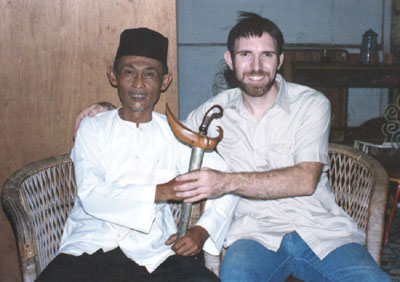
Circle of Creation

Circle of Creation for training
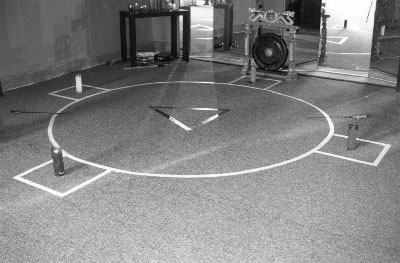
Pendekar Sartono

Pendekar Sartono and his wife
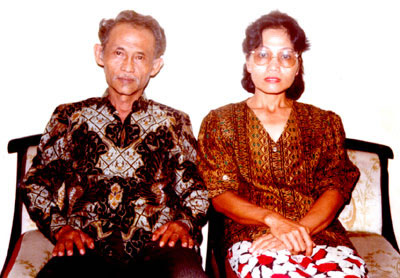
Pendekar Sartono's sons prepare for fasting and meditation

Pendekar Sartono and one of his sons at the grave site of his father

Front of Pendekar Sartono's fathers house
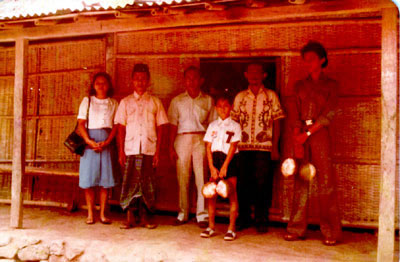
Path leading to gravesite of Untung Suropati
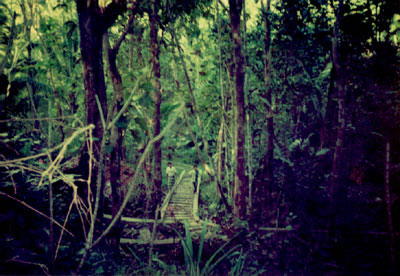
Path leading to gravesite of Untung Suropati

Entrance to gravesite of Untung Suropati
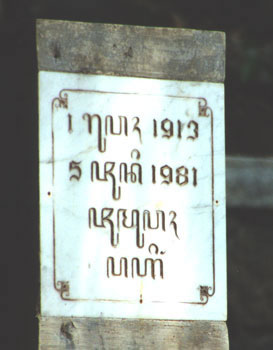
The direct descendant of Untung Suropati's house which is next to the orginal house

Outside of the tomb area

Outside of the tomb area
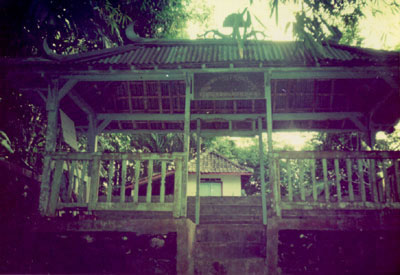
Front of Untung Suropati's old house

Pendekar Sartono's sons meditating at the tomb
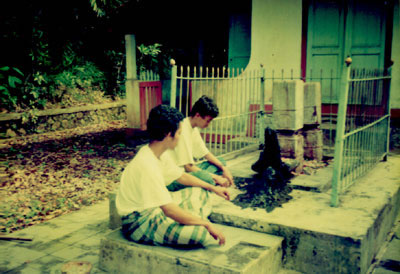
Fire Ceremony at the tomb
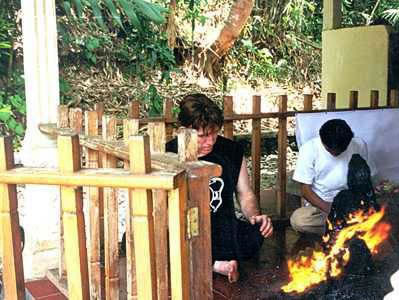
Fire Ceremony at the tomb with Pendekar Sartono

Group Photo with Pendekar Sanders (left),Pendekar Sartono (middle)
and a direct descendant of Untung Suropati next to him
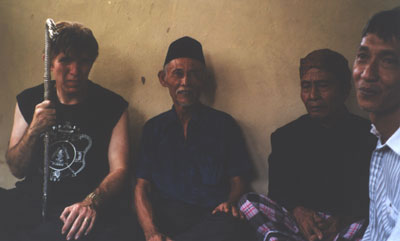
Inside Untung Suropati's old house Pendekar Sartono points to the
head wrap of Untung Suropati with Circle of Creation in the center
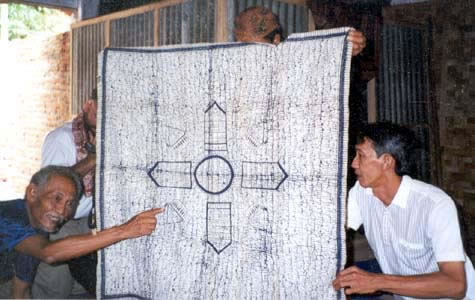
Inside Untung Suropati's old house and some of his Pusaka
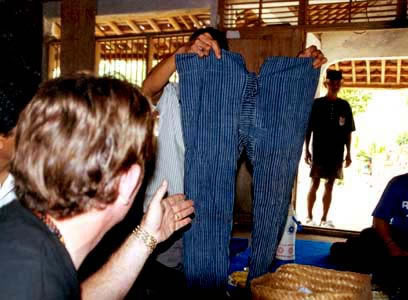
Inside Untung Suropati's old house and some of his Pusaka

Pendekar Mama Sukarma direct student of his father Bapak Bagasol
Cimande Tarik Kolot Patch

Symbolic Meanings
The arm at the top symbolizes strength.
The handshake at the bottom represents friendship and
brotherhood among the Pendekars of whatever lineage.
The tiger in the middle represents Cimande/Bogor.
On the right side we see cotton bolls. Cotton
is used to plug the orifices of the dead and cotton cloth is also
used for the shroud.
On the left side of the flag we see rice leaves.
Padi or rice is what people eat for sustenance and thus, the two
symbolize life and death.
Padi and cotton are also the symbols of
what a student
was to offer the teacher, that is food for training and cotton
for clothes. If the student was to get killed in his training it was
the cotton that would be used to wrap the body for burial. These
symbols
are also found in the Garuda Pancasila as they represent "Sandang",
and "Pangan," "cotton
and "rice". Sandang and Pangan are two of the
three primary needs in Kejawen philosophy. Sandang represents
clothing,
protection,
etc. Pangan represents the source of human's primary need
for life.
Pendekar Mama With Cabang
Cimande Photos

Mah Lasium grave site |
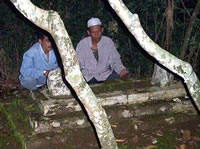
Mah Lasium grave site |

Mah Bagasol grave site |

Mah Bagasol grave site |

Grave area for Mah Pangering,
Raudin, Onang, Labudin |

Mah Anguh grave site |
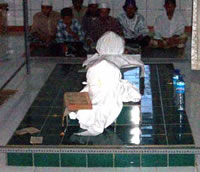
Mah Eyang Sarian grave site |

Mah Eyang Sarian grave site |

Mah Muharrin grave site
|
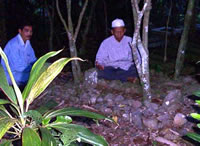
Mah Muharrin grave site
|

Cimande Instructor
|
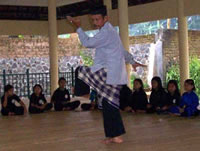
Cimande Instructor |
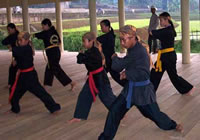
Tarian training |
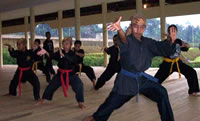
Tarian training |
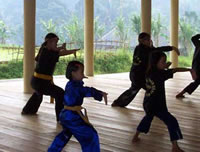
Tarian training |
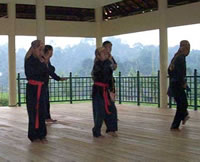
Cimande Training |

Cimande training |

A Cimande school flag |
A Written Statement by a Member of the Badui Tribe
From the onset of the existence of the Badui tribe of the Banten area, lots
of handcrafts and occult products have been produced; however, since its
early days until the present, the art of self-defense does not exist and
has never been cultivated.
If seen to exist, it is simply possessed by Badui individuals that have
acquired and studied the art from external sources. Thus, emphatically stated,
the Badui tribe do not possess any “Pencak Silat” (or cultivated
any martial-art) in the past or the present.
Bogor, June 30 2002
Bapak Sarman

Inside the Badui Village |

Inside the Badui Village |

Entrance into Badui lands |

Badui Guide |
Badui Original Letter

About Cimande
The Three Lineages
At Mbah Lasiun's request, Mbah Kahir stayed at Cimande Nanggoh
to train the three students. All branches or lineages of Pencak Silat Cimande
can be traced to these 3 students:
1. Mbah Muharrin (man)- received the complete Cimande Ilmu
1a. Bapak Bagasol
1b. Pendekar Mama Sukarma
2. Mbah Ratmah (woman) was given the Segelap Mapar - the power voice.
3. Mbah Ace (man) was given certain prayers (devotional?)
3a. Bapak Ace Sutisna
The Cimande village existed long before Tarik Kolot. The original students
of Embah Kahir lived in Cimande. Mbah Lasiun requested Ace to move and develop
Cimande Girang. The people at Cimande Nanggoh called the place where
Ace settled (Cimande Girang), "Narik
Kolot" literally meaning "pulled the elder."
Embah Ace, his descendents,
and the people there from their own perspective called it "Tarik
Kolot" meaning "the
elder moved with satisfaction". Cimande Girang has been changed
to Tarik Kolot and because of its development/progress is now independent
of Cimande. In
contrast the sometimes asserted translation of "the old vanishing
garden" interpretation
for Tarik Kolot does not make sense.
Mbah Kahir
Approximate Dates |
Events |
unknown |
Birth and location |
unknown |
Began to teach Sera style |
unknown |
Began to teach Pamacan style and Trumbu |
1760 |
Lived in a village of Cogreg, Bogor and began to teach Cimande |
1773 |
Fought against a fighter from Macao in Cianjur |
1776-1813 |
When doing business in Cianjur, he met with the 4th city mayor
of Cianjur, Raden Adipati Wiratanudatar. He then decided
to move to Cianjur and lived in Kamurang village. |
1815 |
Came back to Bogor, he begat 5 "sons" which are
Endut, Ocod, Otang, Komar and Oyot. |
1825 |
Died |
Embah Kahir
[Source: Passage from the book, Learning Silat, page 10, by Mr.
R Asikin, Bandung, August 1975 and authorized by H. Suhari Sapari, The
General
Leader
of
PPSI "The Indonesian Self Defense Association" of West Java,
and the IPSI, Ikatan Pencak Silat Indonesia]
Original Indonesian text
Yang mula-mula memberi pelajaran di Jawa Barat, hidup pada pertengahan
tahun 1780, tinggal di kampung Cogreg, Bogor. Alirannya disebut Cimande,
karena di tempat Embah Kahir ada kali yang bernama Cimande dan murid-muridnya
berlatih di kali tersebut.
Beliau mempunyai banyak murid yang menyebar-luaskan pelajarannya; di
Bogor, Jakarta, Banten, Bandung dan tempat-tempat lain di Jawa Barat.
Pada tahun 1773 beliau pernah bertanding dengan orang Macao di Cianjur,
disaksikan oleh Pangeran Kornel, yang pada waktu itu menjadi Kepala
Cutak (Wedana) di Cianjur.
Murid-murid Embah Kahir yang terpenting ialah: "Bapak Sera", yang mempunyai
banyak murid di Depok, Bogor, Jakarta, Tangerang dan Banten.
Yang menyebar-luaskan pencak Cimande di Bandung yaitu terutama anak-anak
Embah Kahir sendiri sebanyak 5 orang, yaitu: Bapak Endut, Ocod, Otoy,
Komar dan Oyot.
Kemudian datang lagi di Bandung dari Bogor yang mengajarkan pencak
Cimande, yaitu Bapak Bidong, Mailin dan Bapak Abo.
He was the master of "Cimande", clan. He introduced the "Cimande" fighting
system to the West Javanese. He called his clan "Cimande" for
the place where he lived had a river called the Cimande River. He lived
in a small village called the "Congreg" near the town of
Bogor in West Java, around, 1780.
Embah Kahir had many students in many
places like: Bogor, Jakarta, Banten, Bandung, and else where in West
Java. In 1773, he fought against a fighter from Macao in Cianjur,
a small town in West Java. It was witnessed by the chief of the district
of
Cianjur called the Prince of Kornel.
His very well known student was "Bapak Sera", who had many students in
Depok, Bogor, Jakarta, Tangerang, and Banten.
Embah Kahir's five students who
spread Cimande in Bandung were: Bapak Endut, Ocod, Otoy, Komar, and
Oyot.
There were three other students who came from Bogor to Bandung and
taught Cimande, namely: Bapak Bidong, Mailin and Bapak Abo.
The Myth of Maempo Cimande
[Source: Interview with Bapak Rifai, Guru Pencak
Silat Cimande Panca Sakti in Jakarta, 1993]
Original Indonesian text
Tak jauh di tepian sungai Mande sebuah keluarga pedagang bernama Kahir
hidup tinggal temtram dan damai. Di suatu hari istrinya pergi kesungai
untuk melakukan kegiatan sehari-hari mencuci pakaian, makanan dan membuang
hajat. Di saat istrinya mencuci pakaian di seberang tampak segerombolan
monyet memungut buah kupak di tepian sungai, selang waktu kemudian datang
seekor macan (maung) di tempat yang sama. Monyet-monyet itu merasa terusik
kenyamanannya dengan kedatangan macan, monyet-monyet itu menjerit jerit
mengeluarkan suara sekeras-kerasnya. Suasana itu mengejutkan istri Kahir
untuk memperhatikan keadaan , kemungkinan apa yang terjadi. Macan itu
marah mengaung dan menyerang ke arah monyet dengan tangannya yang kekar
tetapi monyet yang bertubuh kecil itu, merasa tidak takut, meloncat dengan
berkelid kembali menyerang dengan mengigit di bagian perut macan. Macan
menggeliat kembali melakukan serangan- serangan namun tidak menyentuh
tubuh monyet. Sebaliknya monyet yang lain dengan meggunakan tangkai kayu,
mencoba mengganggu macan agar supaya marah dan menyerangnya kembali.
Pada saat yang sama monyet kembali berkelit dan mengigitnya. Kejadian
ini detik demi detik diperhatikan dan diamati oleh Ibu Kahir direnungkan
kembali teknik perkelaian itu. Sebagai akibatnya pekerjaannya tertinggal
tidak terselesaikan tepat waktu, sehingga Ibu Kahir kembali ke rumah
terlambat dan belum memasak makanan siang. Keterlambatan memasak ini
membuat Pak Kahir marah terhadap istrinya tak mau mengerti . Istrinya
mencoba menjelaskan tetapi suaminya marah dengan menempeleng istrinya,
dengan gerakan cepat berkelid , serangan itu dapat dihindari.Kemarahan
yang tidak terkontrol itu meluap-luap dilakukan dengan pukulan demi pukulan
namun tak berhasil menyentuh istrinya, cukup diatasi dengan gerakan kelid.
Pak Kaher nafasnya terengah-engah, bertanya kepada istrinya: "Di
mana kamu belajar maen poho?" (artinya "menipu gerakan" dipersingkat
menjadi "maempo"). Istrinya menjelaskan kepada suaminya , dia
terlambat kembali dari sungai disebabkan lama sedang asik menikmati perkelaian
(maung) macan dan monyet. Sejak itu Kahir bertanya-tanya bagaimana gerakan
tadi, istrinya dengan rajin memberikan contoh gerakan kelid. Kahir dengan
cermat memulai memikirkan menjadi gerakan perkelaian yang kini dikenal
dengan nama "jurus kelid pamonyet", monyet menyerang dengan
tangkai kayu menjadi "jurus pepedangan" dan serangan tangan
yang kokoh dikenal"jurus pamacan". Karena posisi macan sewaktu
menyerang monyet kedua kakinya sedang berada di posisi duduk dan monyet
menggunakan posisi kuda-kuda rendah, maka latihan dasar Cimande pertama-tama
jurus kelid dimulai dari posisi macan yaitu duduk dan tingkat berikutnya
mulai latihan dari posisi berdiri dengan kuda-kuda pamonyet(rendah).
Berikutnya teknik mempo' ini terus dikembangkan oleh Kahir dan masyarakat
setempat memberikan nama maenpo' Cimande. (Sumber wawancara dengan Bapak
Rifai Guru Pencak Silat Cimande Panca Sakti di Jakarta 1993)
Hidup guru Kahir
(kutipan singkat dari Gema Pencak Silat Vol. 3, no. 1:18-19)
Kahir tinggal di kampung Cogreg, Bogor menjadi pendekar yang disegani
kira-kira pada tahun 1760 pertama kali memperkenalkan kepada murid-muridnya
jurus mempo' Cimande. Kemudian murid-muridnya menyebarkan luaskan kedaerah
lainnya seperti Batavia, Bekasi, Karawang, Cikampek, Cianjur, Bandung,
Garut, Tasikmalaya, Sumedang, Ciamis, Kuningan, dan Cirebon. Sewaktu
beliau tinggal di Cogreg Bogor, Kahir sering bepergian jauh meninggalkan
kampung halamannya untuk berdagang kuda. Pengalamannya sering di begal
oleh rampok dan bandit namun keadaan itu dapat diatasi karena kepiawaiannya
bermain maempo'. Di Batavia berkesempatan berkenalan dengan pendekar-pendekar
silat Minangkabau dan Cina yang ahli dalam dunia persilatan untuk saling
mencoba dengan bertukar pengalaman. Pertemuan dengan ahli silat lain
ini memberikan cakrawala untuk membuka wawasan pandangan tentang permainan
yang dimilikinya berinteraksi dengan budaya lain. Ketika berdagang di
Cianjur, beliau bertemu dengan Bupati Cianjur ke VI yakni Raden Adipati
Wiratanudatar(1776-1813) Beliau menetapkan pindah ke Cianjur dan berdomisili
di kampung Kamurang. Raden Adipati Wiratanudatar mengetahui bahwasanya
Kahir mahir bermain mempo' untuk itu memintanya untuk mengajar keluarganya,
pegawai kabupaten dan petugas keamanan. Untuk membuktikan ketrampilannya,
bupati mengadakan adu tanding melawan pendekar dari Cina dengan permainan
kuntao Macao di alun-alun Cianjur. Pertandingan yang dimenangkan oleh
Kahir ini membuat namanya semakin populer di Kabupaten Cianjur. Pada
tahun 1815 Kahir kembali ke Bogor, beliau memiliki 5 putra yaitu Endut,
Ocod, Otang, Komar dan Oyot. Dari kelima anak inilah Cimande disebarkan
keseluruh Tanah Pasundan. Sementara di Bogor yang meneruskan penyebaran
Cimande adalah muridnya yang bernama Ace yang meninggal di Tarik Kolot
yang hingga kini keturunannya menjadi sesepuh pencaksilat Cimande Tarik Kolot
Kebon Jeruk Hilir. Pada permulaan abad XIX di Jawa Barat adalah masa-masa
kejayaan Cimande sehingga cara berpakaian Kahir dengan menggunakan pakaian
celana sontok atau pangsi dengan baju kampret menjadi model pakaian pencak
silat hingga kini. Pada tahun 1825 Kaher meninggal dunia sedangkan buah
karyanya terus berkembang dan diterima secara luas oleh masyarakat Jawa
Barat. Pola pendidikannya dikembangkan oleh anak didiknya seperti Sera'
dan aliran Ciwaringin yang dalam perkembangannya mengadakan perubahan
jurus seperti yang dilakukan Haji Abdul Rosid. Akan tetapi berubahan
itu tidak jauh berubah dari pakem mempo'Cimande . Dewasa ini Cimande
sudah berkembang ke seluruh pelosok dunia, masalahnya Kahir meninggalkan
maempo Cimande tidak berupa catatan tertulis , oral tradisi yang tidak
sistimatis. Di desa Cimande, maempo' Cimande tidak berada di dalam tatanan
yang terpadu seperti organisasi. Maempo Cimande perkembang bermula dari
keturunan dan keluarga yang tidak terorganisir dalam waktu yang panjang
telah menghasilkan murid-murid yang banyak dan dari senilah berkembang
dengan seizin atau tidak menjadi perguruan-perguruan Cimande yang baru
yang satu dengan yang lain tidak aling mengenal lagi. Setidak tidaknya
Cimande menjadi bagian dasar pendidikan aliran-aliran pencak silat baru
yang sudah banyak tersebar diseluruh dunia.
Pola dasar Cimande
(kutipan singkat dari Gema Pencak Silat Vol. 3, no. 1:20-22)
Cimande pada mulanya menggunakan teknik perkelaian dengan jarak jauh,
yaitu pesilat mengambil jarak jangkau selepas kaki, jarak ini dimungkinkan
untuk dapat mudah menghindari serangan lawan. Jarak ini menjadi jarak
dominan untuk serang balik. Setiap pesilat dalam melakukan serangan harus
memperhatikan sikap kaki atau kuda-kuda yang bertujuan untuk menjaga
jarak lawan. Kuda-kuda pipih yang digunakan dapat dengan mudah dipindah-pindah,
dan dapat diubah-ubah dalam kecepatan dan frekuensi tinggi. Karena dipastikan
lawan akan memberikan serangan jarak dalam bentuk pukulan atau tendangan
cepat dan tinggi, untuk mengatasinya maka diperlukan jurus agar pesilat
dapat mengimbanginya. Secara garis besar Comande dibagi dibagi dalam
tatanan yaitu: Kelid Cimande, Pepedangan Cimande dan Tepak Selancar.
Kelid dan Pepedangan merupakan jurus beladiri, sedangkan Tepak Selancar
Jurus Seni (dengan iringan musik gendang pencak).
1. Jurus Kelid Cimande
Jurus ini adalah jurus inti yang bertujuan menangkis serangan lawan
dengan berusaha merobohkannya. Kelid artinya menangkis serangan lawan
sambil berusaha merobohkannya.
Jurus ini berjumlah 33 jurus yaitu:
1.tonjok bareng,
2.tonjok saubelah,
3.kelid selup,
4.timpah seubelah,
5.timpah serong ,
6.timpah duakali,
7.batekan,
8.teke tampa,
9.teke purilit
10.tewekan,
11.kedutan,
12.guaran,
13.kedut guar
14.kelid dibeulah
15.selup dibeulah,
16.kelid tonjok
17.selop tonjok
18.kelid tilu,
19.selup tilu
20.kelid lima
21.selup lima
22.peuncitan,
23.timpah bohong
24.serong panggul,
25.serong guwil,
26.serong guar,
27.singgul serong,
28.singgul sebelah,
29.sabet pedang,
30.beulit kacang,
31.beulit jalak pengkor
32.pakala alit
33.pakala gede
Jika diperhatikan jurus kelid ini nampaknya tertumpu pada ketangguhan
tangan sebagai inti kekuatan, seperti:
Tonjok : bentuk tangan mengepal
Teke : menggunakan ruas jari tangan
Tewekan : bentuk tangan pipih menusuk
Kedutan : menggunakan telapak tangan
Guaran : menggunakan sisi tangan bagian luar aupun dalam
Singgulan : menggunakan pangkal tangan
Secara keseluruhan gerakan jurus kelid terlihat agak unik dari gerakan
silat lainnya yang pada biasanya keuatan serangan
bertumpu kepada kaki seperti silat Minangkabau.
Untuk melatihnya:
Biasanya dilakukan dengan duduk ditempat, sepasang duduk saling berhadapan
salah satu kaki dilipat dan lainnya dilonjorkan kedepan demikian pula
pasangannya dengan posisi sebaliknya. Pasangan itu melakukan serang
bela dalam posisi duduk . Tujuan latihan ini untuk melatih daya emajinasi
seseorang untuk menentukan kuda-kuda yang tepat saat jurus-jurus tersebut
dilakukan dengan posisi berdiri. Dengan dikuasainya gerakan tangan
tentunya secara otumatis dapat dengan mudah menggunakan kuda-kuda dan
serang bela.
2. Jurus pepedangan Cimande
Jurus ini bertumpu kesigapan kaki dan teknik serangan senjata golok.
Dalam latihan digunakan senjata dari bambu sebagai pengganti senjata
yang sesungguhnya. Jurus pepedangan ini berjumlah 1 rangkaian jurus yaitu
elakan sebeulah - selup kuriling - jagangan - tagongan - piceunan - balungbang-
balumbang - sabeulah - opat likur - buang dua kali - selup kuriling langsung
- selop bohong.
3. Jurus Tepak Selancar
Jurus ini hanya disajikan sebagai keindahan gerak karena jurus jurusnya
memiliki unsur keindahan dan setiap penampilannya harus diiringi musik
gendang pencak yang terdiri dari dua gendang besar(indung) dan dua gendang
kecil(kulantir) yang berperan sebagai pengiring gerakan dan mengatur
tempo lagu. Terompet sebagai melody lagu dan gong kecil (kempul) atau
bende dalam penampilannya gerakan pencak selalu ditikberatkan dengan
iringan gendang. Pakem musik yang sudah baku ialah: tepak dua, tepak
dungdung , paleredan, golempang dan tepak tilu.
Calon murid dan kode etik
(kutipan singkat dari Gema Pencak Silat Vol. 3, no. 1:20-22)
Setiap calon murid Cimande yang akan mengikuti latihan terlebih dahulu
harus menyatakan kesediaannya mematuhi tatacara atau etika perguruan
yang amat dihormati; Syarat-syaratnya ialah harus melalui rangkaian upacara
tradisi seperti puasa selama 7 hari yang dimulai dari hari Senin atau
Kamis.
Selanjutnya membacakan sumpah atau janji (Patalekan Cimande)
1. Harus taat sdan taqwa kepada Allah dan Rasulnya
2. Jangan melawan kepada ibu dan bapak
3. Jangan melawan kepada guru dan ratu(pemerintah)
4. Jangan berjudi dan mencuri
5. Jangan ria, takabur dan sombong
6. Jangan berbuat zinah
7. Jangan bohong dan licik
8. Jangan mabok-mabokan dan menghisap madat
9. Jangan jahil dan menganiaya sesama mahluk Tuhan
10. Jangan memetik tampa ijin, mengambil tampa minta,
11. Jangan suka iri hati dan dengki
12. Jangan suka tidak membayar hutang
13. Harus sopan santun, rendah hati dan saling harga menghargai diantara
sesama manusia.
14. Berguru Cimande bukan untuk gagah-gahan , kesombongan dan ugal-ugalan
tetapi untuk mencapai keselamatan dunia dan
akhirat.
Patalekan Cimande dijelaskan sedemikian rupa dan diulang-ulang kepada
calon murid hingga murid benar-benar memahaminya dan mematuhinya dengan
dipegang tangannya oleh guru sebagai tanda kesanggupan . Berikutnya guru
membacakan do'a tawasul dan meneteskan air bercampur daun sirih ke mata
sang murid (dipeureh) tradisi ini disebut upacara keceran untuk menajamkan
pandangan mata. Pada dasarnya Cimande ini berfungsi sebagai media siar
agama Islam oleh karena itu ketaatan kepada Allah dan Rasulnya dengan
menjalankan segala perintahnya dan menjahui larangannya merupakan syariat
yang harus ditaati warga Cimande. Cimande merupakan pengisi dan pengekang
nafsu hewani dan sifat-sifat lain yang dapat merugikan semua pihak. Hal
ini Cimande bukan bertujuan untuk menguasai dan berkuasa atas diri manusia
lainnya. Pada hakekatnya Talek Cimande adalah roh dari pencaknya, tampa
Talek Cimande, pencak Cimande ibarat mayat yang menebarkan bau busuk
yang menyesakkan.
Semoga informasi ini berfana'at memberi gambaran apa dan bagaimana Cimande.
Selamat menjalankan ibadah puasa dan semoga tetap afdol puasanya.
Not far from the Mande river shore was a family of a merchant by the
name of Kahir who lived in peace and calm. One day his wife went toward
the river to run her daily errants such as washing laundry, cleaning
food materials and relieving herself. When the wife was washing laundry
she saw a school of monkeys across the stream, picking up "kupak" fruit
along the river shore. Not too long after that a tiger appeared at the
same place. Feeling that the presence of the tiger was very disturbing,
the monkeys screamed and made loud noises, as loud as they could. Kahir's
wife was alerted and wondered what would happen next. The tiger roared
furiously and charged towards the monkeys with its strong paws, but the
little monkeys, not showing any fear at all, dodged the tiger and striked
back by biting on the tiger's stomach. The tiger struggled and striked
back, but his attacks did not prevail over the monkeys. On the other
hand the other monkeys, using branch sticks, they tried to divert the
tiger's attention and made him even more angry and jumped on them again.
But at the same time the monkeys dodged the attack and bit on him again.
Ibu Kahir was carefully watching this moments by moments, she comprehended
every movements which appeared to be as a fighting technique. As a result,
she didn't finish her job in time, she arrived home late and did not
prepare lunch yet. Her delay in preparing lunch made Mr. Kahir very upset
at her and he didn't want to understand her, though she tried her best
to explain. He got so upset and that he tried to slap her on the face.
She dodged and escaped the slapping. Her husband got even more upset
and lost control over himself. Blow by blow he tried to land on his wife,
but none were able to touch her. She always managed to dodge the blows.
Panthing and out of breath, Mr. Kahir asked his wife :"where did
you learn to play poho?" (poho means to perform "deceiving
moves", or "maempo" for short). The wife explained to
her husband that her delay was due to her return from the river, after
having watching an interesting fight between the tiger and the monkeys.
After that Mr. Kahir dilligently asked his wife how those swift moves
were done, and his wife showed him some samples. Mr Kahir would recall
those fighting moves and it is now known by the name "jurus kelid
pamonyet" (dodging monkey style). The monkeys attacking by using
branches is known as "jurus pepedangan" (sword move) and striking
of the tiger with both of its strong paws is known as "jurus pamacan" (tiger
style). Because the tiger's position when charging against the monkeys
was with both rear legs in squatting position and the monkeys were using
low stance position, thus the basic moves for Cimande is first - jurus
kelid (dodging moves), starting from the tiger's sitting position and
the next step is standing low (low stance) monkey style. The maempo teknik
was continuously developed by Mr. Kahir and the locals called it by the
name of maempo Cimande.
The Life of Guru Kahir
[Short essay quoted from Gema Pencak Silat Vol 3 no. 1:18-19]
Kahir lived in a village of Cogreg, Bogor. He became a feared pendekar
around the year 1760 which was when he first introduced to his students
the maempo Cimande moves. His students then spread it out to other regions
like Batavia, Bekasi, Karawang, Cikampek, Cianjur, Bandung, Garut, Tasikmalaya,
Sumedang, Ciamis, Kuningan, and Cirebon.When he was living in Cogreg,
Bogor, Kahir used to travel far, leaving his hometown for trading horses.
There has been many attempts to rob him, but he was able to overcome
them all because of his skills in playing maempo. In Batavia he was able
to get acquainted with other silat pendekar(s) from Minangkabau and Cina
- masters in the world of silat, and he traded experiences with them.
His meeting with other silat pendekar gave him an idea to broaden his
horizon by accepting other cultures into his own. When doing business
in Cianjur, he met with the 4th city mayor of Cianjur, Raden Adipati
Wiratanudatar (1776-1813).
He then decided to move to Cianjur and lived
in Kamurang vilage. Raden Adipati Wiratanudatar knew that Kahir is skillful
in playing maempo and he asked him to teach him and his family, all regional
and security officers. In order to prove Kahir's his skills, the mayor
challenged him to a fight against a Chinese master of Kuntao Macao in
alun-alun (park) Cianjur. Kahir won the fight and made himself more popular
among the people in Cianjur region. In 1815 Kahir came back to Bogor,
he begat 5 "sons" which are Endut, Ocod, Otang, Komar and Oyot. By his
5 sons was Cimande widely spread throughout the land of Pasundan (Western
Java). Meanwhile in Bogor, Cimande was successed by his student, Ace,
who died in Tarik Kolot. His descendants have become the elders of pencaksilat
Cimande Tarik Kolot Kebon Jeruk Hilir. The beginning of the 19th century
was when Cimande reached it's glorious moments in West Java, that Kahir's
typical clothing of "sontok" or "pangsi" shorts (very
loose/baggy shorts) with "kampret" shirt has become the model
uniform of pencak silat until present.
In 1825 Kahir died and his fighting
art is continuously developing and widely accepted by people of West
Java. His training methods was developed by his pupil such as Sera'
and Ciwaringin style which along the way made some changes in the moves
such
as done by Haji Abdul Rosid. However, the changes is not too much different
than the basic maempo Cimande moves. Today Cimande has developed and
widely spread unto different corners around the world. The problem
has been that Kahir did not put his teaching in writings, but oral tradition
which is not systematic. In the village of Cimande, maempo Cimande
is
not in an organized form. From one family to another, the Cimande is
passed down from one generation to another in an unorganized manner
that it produced many students and branched many schools, legaly as well
as
illegally, not familiar with one another. At least Cimande has become
the basic for other silat moves that later developed and branched out
world widely.
Basics of Cimande
[short essay from Gema Pencak Silat Vol. 3, no. 1:20-22]
Originally, Cimande was using long distance fighting techniques, i.e.
the fighter would stand within a distance of a few feet from the opponent,
which will make it possible for the fighter to dodge opponet's attack.
The distancalso makes it dominant for counter attacks. In launching attacks,
every fighter (pesilat) should always pay close attention to position
of feet or stance and keep a certain distance from the opponent. The
use of Kuda-kuda pipih (flat stance?) can easily be adjusted/increased
in
speed or frequency,
as one can expect an opponent to strike with a fast punch or kick within
a distance. Therefore one need to adjust one's own speed in order to
level with the opponent. In essence, jurus (moves) of Cimande is devided
into : Kelid (dodging) Cimande, Pepedangan (sword fight) Cimande and
Tepak Selancar(?). Kelid and Pepedangan are self defense techniques whereas
Tepak Selancar is a demonstrative art moves (accompanied with pencak
drum beats).
1. Jurus Kelid Cimande (Cimande dodging techniques) :
These moves is the core moves which is meant for blocking and knocking
down of an opponent.
There are altogether 33 moves (jurus) :
| 1. |
tonjok bareng (simultaneous punch) |
| 2. |
tonjok saubelah (single punch) |
| 3. |
kelid selup (dive dodge) |
| 4. |
timpah seubelah (single strike) |
| 5. |
timpah serong (side strike) |
| 6. |
timpah duakali (double strike) |
| 7. |
batekan |
| 8. |
teke tampa |
| 9. |
teke purilit |
| 10. |
tewekan |
| 11. |
kedutan |
| 12. |
guaran |
| 13. |
kedut guar |
| 14. |
kelid dibeulah |
| 15. |
selup dibeulah |
| 16. |
kelid tonjok (dodge & punch) |
| 17. |
selop tonjok |
| 18. |
kelid tilu |
| 19. |
selup tilu |
| 20. |
kelid lima |
| 21. |
selup lima |
| 22. |
peuncitan |
| 23. |
timpah bohong (mock strike) |
| 24. |
serong panggul |
| 25. |
serong guwil |
| 26. |
serong guar |
| 27. |
singgul serong |
| 28. |
singgul sebelah |
| 29. |
sabet pedang |
| 30. |
beulit kacang |
| 31. |
beulit jalak pengkor |
| 32. |
pakala alit |
| 33. |
pakala gede |
We can see that the dodging techniques is stressing on the hands as
source of power/strength. For example :
| Tonjok |
forming fist |
| Teke |
using fingers |
| Tewekan |
finger tips thrusting flat |
| Kedutan |
hand palm |
| Guaran |
using outer or inner side of hand |
| Singgulan |
using wrist |
In all, the Jurus Kelid looks somewhat unique
compared to other styles/moves where stress is put on the feet, like
silat Minangkabau.
How to Train
This is usually done in pairs by sitting position, two
facing each other, one leg extended and one folded. Sparring partners
performing strikes
and defense in sitting position. Purpose of this training is to develop
one's imagination to figure out and decide which stance and moves
are proper to be used in a standing position. If hand moves is mastered,
the proper stance to use can easily be determined.
2. Jurus Pepedangan Cimande (Cimande Sword Style)
This style is stressing on the flexibility of the feet and striking
techniques using the Golok. Bamboo is used to replace the sword when
doing training or mock fight. The pepedangan consists of 1 set of flow
of moves, i.e.
elakan sebeulah - selup kuriling - jagangan - tagongan -
piceunan
- balungbang - balumbang - sabeulah - opat likur -
buang dua kali
- selup kuriling langsung - selop bohong |
3. Jurus Tepak Selancar (Demonstrative)
This style is only performed for the beauty as each moves is very artistic
and is followed by music in form of pencak drum beats, which includes
2 large drums (indung) and 2 smaller drums (kulantir), which regulates
the rhytm. Melody of the trumpet and as small gong (kempul) or bende
which accompanies every moves should follow the beating of drums.
Common
standard music titles are : Tepak Dua, Tepak Dungdung, Paleredan, Golempang
and Tepak Tilu.
Student candidate and code of ethics
[short essay from Gema Pencak Silat Vol.3 no.1:20-22]
All candidates of Cimande students are required to obey and honor certain
rules and code of ethics of the school before entering into training.
One of the requirements is to go through a serius of traditional 7 day
fasting from Monday through Thursday.
The following step is to read Cimande swear or oath (Patalekan Cimande)
:
| 1. |
Faithful and obedient to God and His apostles |
| 2. |
Respectful to parents |
| 3. |
Respectful to teacher and government (ruler) |
| 4. |
Avoid gambling and stealing |
| 5. |
Avoid arrogance, boasting or showing off |
| 6. |
Avoid adultery |
| 7. |
Avoid lies and deception |
| 8. |
Avoid drunk and drugs |
| 9. |
Do not take advantage or abuse fellow creatures of God |
| 10. |
Do not pluck nor take without permission |
| 11. |
Avoid envy and hatred |
| 12. |
Do not avoid paying debts |
| 13. |
Always be polite, humble and appreciative to other fellow human
beings |
| 14. |
Learning Cimande is not for showing off, boasting or for acting
recklessly, but for achieving safety on earth and in heaven. |
Patalekan Cimande is explained in such a way and repetitively to student
candidates in order for them to fully understand and comprehend while
their hands are being held by the teacher as symbol for acceptance. The
next step is for the teacher to say a prayer, tawasul, and drop a mixture
of water and bettelnut (sirih) extract to the student's eye (peureh),
this tradition is called "keceran" and is meant to sharpen
the student's eyes. The function of Cimande is basically for spreading
Islam, and therefore the devotion for God and His apostles while doing
all of His commands and avoid the taboos is a must to all Cimande practitioners.
Cimande is used for controlling all animal lust and other lust that does
not benefit human beings. Cimande is not to be used for controlling (or
having superiority against) other human beings. Talek Cimande is basically
the spirit of the pencak itself, without Talek Cimande, the pencak is
like a corpse without soul which spreads out an unpleasant (rotten) smell.
May this information be benefecial in describing the whats and hows
of Cimande. May you success in your fasting.
Cimande Seated Jurus
Listed below are 3 styles of Cimande Seated Jurus. The Girang
Style is documented in both paper and photos format (The 12th Principle).
The Maempo Style is listed in an article on Cimande and the Tarik Kolot
Style will be documented at a latter date in both print and video formats.
The Tarik Kolot Style has fewer jurus since it does not have as many
duplicates with only minor variations as the other two styles.
Girang Style
A - Tonjok Bareng
B - Tonjok Sebelah
1 - Kelid
2 - Selup
3 - Tenggel Satu
4 - Tenggel Dua
5 - Corok Timpah
6 - Tarikan
7 - Tekea
8 - Bui Teke
9 - Sabet Pedang Bawah
10 - Sabet Pedang Atas
11 - Guaran
12 - Kebut Keluar Kajero
13 - Serong Kebut
14 - Kelid Diblah
15 - Selup Diblah
16 - Kelid Totog Kebawah
17 - Selup Totog Kebawah
18 - Pencitan
19 - Bagolan
20 - Serong Bagol
21 - Serong Petik
22 - Kelid Tilu
23 - Selup Tilu
24 - Kelid Lima
25 - Selup Lima
26 - Serong Panggul
27 - Ajul Gedang
28 - Kakacangan
29 - Pakalah Letik
30 - Pakalah Gede
|
Maempo Style
1 - Tonjok Sareng
2 - Tonjok
Saubelah
3 - Kelid Selup
4 - Timpah
Seubelah
5 - Timpah Serong
6 - Timpah
Duakali
7 - Batekan
8 - Teke Tampa
9 - Teke Purilit
10 - Tewekan
11 - Kedutan
12 - Guaran
13 - Kedut
Guar
14 - Kelid Dibeulah
15 - Selup Dibeulah
16 - Kelid Tonjok
17 - Selop
Tonjok
18 - Kelid Tilu
19 - Selup Tilu
20 - Kelid Lima
21 - Selup
Lima
22 - Peuncitan
23 - Timpah Bohong
24 - Serong
Panggul
25 - Serong Guwil
26 - Serong
Guar
27 - Singgul Serong
28 - Singgul
Sebelah
29 - Sabet Pedang
30 - Beulit Kacang
31 - Beulit Jalak Pengkor
32 - Pakala
Alit
33 - Pakala Gede
|
Tarik Kolot Style
1 - Kelid
2 - Selup
3 - Timpah Sabelah
4 - Timpah Serong
5 - Dug Deggan
6 - Besotan
7 - Teke Surung
8 - Teke Purilit
9 - Teke Guar
10 - Tawex Luar
11 - Tawex Sero
12 - Kepruk Luar
13 - Kepruk Sero
14 - Pamonyet
15 - Kelid Tiga
16 - Kelid Umpat
17 - Kelid Lima
18 - Al-Kalah
19 - Pakalah 1
20 - Pakalah 2
|
Embah Kahir's Grave Site
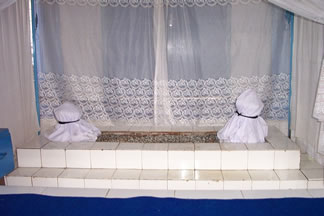

Cimande Area Maps

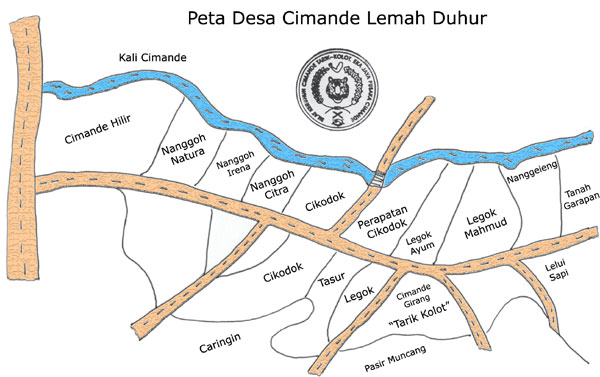
Mas Jud and his Lineage
His Children - Tatang, Cich, Kesih, Kusnadi, Ace, Harazan, Suherman
Mas Jud - Cilisung Students
Mas Jud was brought to Cilisung, Cibilik, in 1965 by Bapak Padma to teach his Pencak Silat and some of those students are listed below:
Lives in Cilisung, Cibilik
-
Bapak Sarmani
-
Bapak Ahmid
-
Bapak Abah Haji Madil
-
Bapak Haji Hassan
Deceased - lived in Cilisung, Cibilik
Deceased - lived in Banten
Mas Jud Cilisung Students
Bapak Ahmid

Bapak Ahmid and an associate demonstrating standing jurus |

Bapak Ahmid and an associate demonstrating standing jurus |
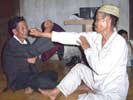
Bapak Ahmid and Bapak Hasan demonstrating the jurus duduk |
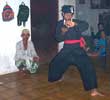
Bapak Ahmid demonstrating Tapak two that Mas Jud called Cikalongon |

Bapak Ahmid demonstrating Tapak two that Mas Jud called Cikalongon |

Bapak Ahmid demonstrating Tapak two that Mas Jud called Cikalongon |
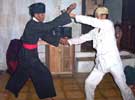
Bapak Ahmid and Bapak Hassan, both former students demonstrating some
jurus of Mas Jud |
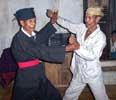
Bapak Ahmid and Bapak Hassan, both former students demonstrating some
jurus of Mas Jud |
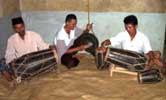
Gendang Players |
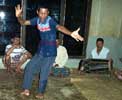
Bapak Ahmid |
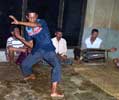
Bapak Ahmid |
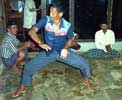
Bapak Ahmid |
Mas Jud Students - Sera, Trumbu and Cabang

Pendekar Jumha
|

Pendekar Apok, a Sera player, using a
golok and doing a Cimande
juru |
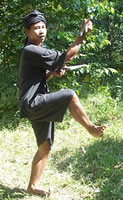
Pendekar Sahrudin with
wooden practice cabang |

Pendekar Sahrudin with
wooden practice cabang |
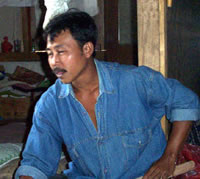
Pendekar Sahrudin - Sera expert |

Pendekar Jumha - Trumbu expert |

Pendekar Mama and the members of the
Cikoneng community in Banten |

Pendekar Mama, Bapak Muis and the
Banten Pendekars |
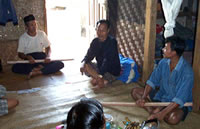
Pendekar Jumha, Pendekar Mama and Pendekar Sahrudin |
Mas Jud Forms
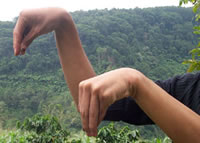
Bangau Hands |
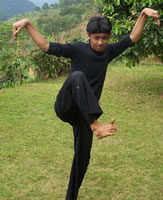
Bangau |
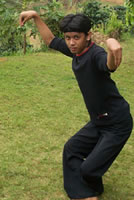
Bangau |

Pamacan |
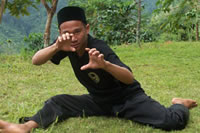
Pamacan |
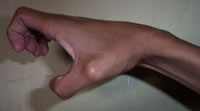
Pamacan Hands |

Monyet Hands |

Monyet Hands |
|
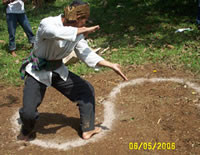
"S" Footwork |

"S" Footwork |
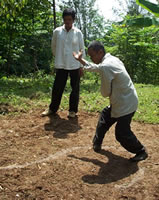
"S" Footwork |
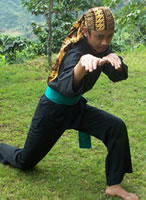
Ular |
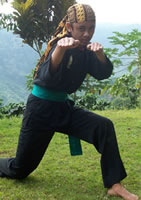
Ular |

Ular Hands |
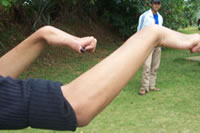
Ular Hands |
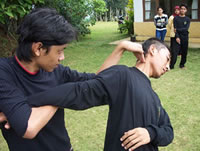
Ular |







































